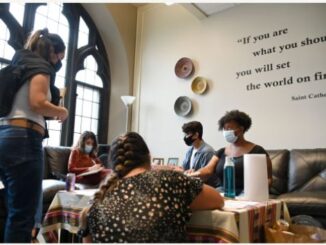
Litzi Duran
Contributing Writer
Several hundred students have used Dominican’s new Preferred Pronoun and Lived First Name tool for online university platforms since it was introduced this semester, according to the university’s chief information officer.
Calling people by their preferred pronouns and lived first names are two components to show solidarity with the LGBTQIA+ community at Dominican. These features have allowed students to be acknowledged by faculty and staff by their pronouns and lived names through certain platforms.
In the past, students with a pronoun or name preference were unable to be fully accommodated in classroom environments. In some instances, professors may accidentally call students by their dead name, a name they no longer associate themselves with, or did not address them with the proper pronouns.
Dominican has been incorporating the lived name feature in any area where a legal first name is not required, such as a university ID cards, student portals (myDU), myDU class rosters and email displays.
The university emphasized the importance of the policy on the university website policy page:
“We provide individuals the opportunity to identify themselves using a lived first name that is different from their legal first name within select university systems. We also affirm that an individual’s pronouns are not simply a preference. They are forms of self-determination and self-affirmation, and so individuals can display pronouns — this fosters a more welcoming and supportive environment.”
The pronoun and lived name policy were both created by the Office of Diversity and Inclusion, the Center for Cultural Liberation, University Ministry, Department of Academic Success and the Director of Data and Innovation.
“Every system on campus has different technical requirements and stores data in unique ways, we in IT needed to carefully examine each one to ensure that pronouns and lived first names could be stored properly and displayed correctly,” said Todd Kleine, chief information officer.
Precious Porras, vice president of diversity, equity and inclusion, said she was happy with the student feedback she has heard.
“The desire was to create a space where students could list their pronouns as well as their chosen name. We want to create a space where students can be their authentic selves and so this was one way we could reach students in a space we weren’t reaching them yet,” said Porras.
By the end of 165 students had used the preferred pronoun feature on Canvas, while 110 had used the lived first name feature.
Although the student response for the launch of these features has been slowly growing, it does not eliminate the possibility of students being misgendered or misidentified.
“I have encountered a student who, despite changing pronouns, has been misgendered in a class,” Porras said. “So, if that happens to students, we encourage students to reach out to either me or Amy Omi.”
The IT department and the Office of Diversity of Equity and Inclusion have created the following step by step guides to show students how they can add their lived first names and pronouns to DU systems.
For any additional assistance or resources, contact either Omi or, for technical assistance, the IT Department.



